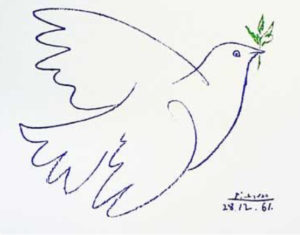
Peace. Pax. Shalom. Salaam. Paix. Pace. In any language, such a small word for such an immense and daunting enterprise. “May there be peace in our time” pleads the ancient prayer. Though has there ever been peace, lasting peace, not simply in our time, but at any time in human history?
The prophet Isaiah, writing in the 9th century B.C.E, envisioned the day when: “The wolf shall dwell with the lamb, and the leopard shall lie down with the kid; and the calf and the young lion and the fatling together; and a little child shall lead them” (Isaiah 11: 6, KJV) . Those events would usher in an era of peace. It is often portrayed as ” The Peaceable Kingdom.’
In our time, sadly, peace still remains distant, elusive, more of a longing than a presence; a biblical promise that has not yet become a permanent reality.
How will each of us recognize, or better yet, usher in peace for the world and our selves?
During a discussion after worship a week ago, a group of us wrestled with Isaiah’s words, which we had heard that morning in worship. One person believed, hoped, it would come as Isaiah had written: when labels like predator and prey (wolf and lamb) will no longer apply and the world will return to a state like the original Garden. When earth and all living things shall be in balance. Peace as an eco-promise.
Someone else believed peace can only arrive when we are united in our common humanity for a common good; when there are no “sides”, no “us and them” and no one is the “other.” More than simply absence of war, peace is when, although differing in opinion and outlook, all will value and respect each other.
Peace, offered a third, is in the delight of silence. And another found moments of peace by moving out from the fray of a speeded-up, stress-filled environment to walk in woods or by a lake.
As I listened to our discussion, I remembered a scene from years ago. Outside my kitchen window I saw the usual flurry of activity at our bird feeder. Sparrows, finches and other small birds were flitting back and forth from feeder to cover, scattering seed on the ground as they flew in, fed, then left. Below, chipmunks, cardinals and squirrels took advantage of the mess to find food; the mourning dove, the largest creature present on the scene, was also there on the ground.
I thought then about the symbolism of the dove: Ambassador of Peace. Along with that thought I knew that I had usually reckoned peace to mean absence of conflict, a state of calm and harmony. Yet what I saw at my feeder was anything but calm. Chipmunks darting back and forth, birds vying for a good spot on the feeder. Meanwhile the dove continued feeding quietly on the ground, all that activity swirling around her. According to the law of the animal kingdom, as the largest creature present one might have expected her to dominate, if not attack the smaller animals. Yet the dove simply continued feeding among the flurry and hurry of life.. If indeed she is a symbol of peace, she is very comfortable with chaos.
As I contemplated this lesson from my avian ambassador, she and all the other birds, along with the small mammals, suddenly disappeared in a flash. What had been full of activity was now empty, the space deserted. An eerie silence hung in the air.
It didn’t take long to discover why. Perched high above in a tall spruce, a magnificent red-tailed hawk kept watch: a primary predator for small animals and birds. Instinctively, they detected its menace and took off. Fear scattered them, death lurked above. The hawk had appeared, a symbol not of peace but of just the opposite: a symbol of war.
I came away from my view out the window with a new awareness. Merriam-Webster’s dictionary defines peace as “tranquility; freedom from disturbance.” Yet what I had witnessed was a whole lot of disturbance at a messy and somewhat chaotic feeding station. All creatures (great and small) were simply carrying on with their lives. Until the hawk appeared when the stillness was almost palpable. My backyard became a dead zone.
Could it be that I had it the wrong way round? War, like the presence of the hawk, has its roots in fear, deep fear that seeps into the soul; a fear that deadens the spirit. Fear which kills, body and spirit. Yes, my backyard was once again calm, but it was, in nautical terms, dead calm!
While, on the other hand, peace is not always a calm, untroubled state. It is messy exactly because we live in our small world of big differences. I believe that is part of the gift of peace. The gift of opportunities to act: to cross bridges, to befriend our enemy and to welcome each and every one to our untidy and noisy tables. Peace as action. Peace as life-giving. Peace as ongoing.
May peace, wherever it shows up in your life, be with you this Advent season.

3 Responses
Thanks, an interesting perspective on Peace. May Peace be with you.
I love this perspective. When I taught kindergarten, one of the most peaceful scenes would be the playground after a snowfall. There was tremendous excitement and activity marked by collaboration as some children worked together to build snow people or structures and others worked alone happily sculpting.
Polly: Very timely and encouraging! Finding peace here in Naples has been the solitary walks on the beach, and here watching the seashore birds.